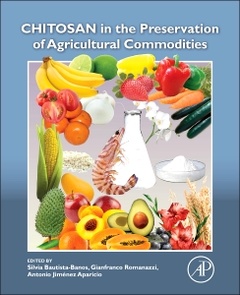Description
Chitosan in the Preservation of Agricultural Commodities
Coordinators: Bautista-Baños Silvia, Romanazzi Gianfranco, Jiménez-Aparicio Antonio
Language: English
Subject for Chitosan in the Preservation of Agricultural Commodities:
Keywords
agricultural and food applications; agricultural applications; agriculture; antifungal activity; antimicrobial; antimicrobial activity; bacterial and fungal activity; biocomposites; biocontrol; biological activity; biological control; biopolymer; blue mold; brown rot; browning enzymes; chemical characteristics; chemical modifications; chitin; chitinous materials; chitosan; Colletotrichum; defense mechanisms; enzymatic activity; enzymatic modifications; essential oils; fruit coating; functional c
Support: Print on demand
Description
/li>Contents
/li>Readership
/li>Biography
/li>Comment
/li>
Chitosan in the Preservation of Agricultural Commodities presents a cohesive overview of research topics regarding the production and characterization of chitosan, the development of coatings and fi lms, its functional properties, and antimicrobial potential of this compound on economically important agricultural commodities. It includes the modes of action from a physiological, enzymatic, and molecular perspective, and evaluations of the activity of chitosan nanocomposites and nanoparticles in biological models.
The first section deals with the chemical characteristics and functional properties of chitosan and new chitosan-based biomaterials intended for food preservation. The second section covers various aspects of the control achieved by chitosan on different microorganisms affecting various horticultural commodities, grains, and ornamentals, and its modes of action. The third section explores enzymatic and gene expression induction by chitosan application on fruit and vegetables; the fourth section offers insight on the use of chitosan nanocomposites in biological models associated with food conservation and control of microorganisms.
PART 1. CHITOSAN OBTENTION AND NEW MATERIALS BASED-CHITOSAN Chapter 1. Chemical Characteristics and Functional Properties of Chitosan Chapter 2. New Bioactive Biomaterials Based on Chitosan
PART 2. BIOLOGICAL ACTIVITY, AND MODE OF ACTION OF CHITOSAN Chapter 3. Application of Chitosan in Fresh and Minimally Processed Fruits and Vegetables Chapter 4. Chitosan Protection From Rice Diseases Chapter 5. Integrated Application of Chitosan Coating with Different Postharvest Treatments in the Control of Postharvest Decay and Maintenance of Overall Fruit Quality Chapter 6. Use of Chitosan to Control Postharvest Decay of Temperate Fruit: Effectiveness and Mechanisms of Action Chapter 7. Chitosan and Its Derivatives as Active Ingredients Against Plant Pests and Diseases Chapter 8. Prospects for the Use of Chitosan and Other Alternatives in Ornamental Conservation Chapter 9. Morphological and Ultrastructural Modifications of Chitosan-Treated Fungal Phytopathogens
PART 3. BIOCHEMICAL AND MOLECULAR ASPECTS OF CHITOSAN Chapter 10. Biochemical Aspects of the Chitin Fungicidal Activity in Agricultural Uses Chapter 11. Chitosan and Changes in Gene Expression During Fruit–Pathogen Interaction at Postharvest Stage
PART 4. CHITOSAN BIO-NANOCOMPOSITES Chapter 12. Chitosan-Based Bionanocomposites: Development and Perspectives in Food and Agricultural Applications Chapter 13. Biological Activity of Chitosan Nanoparticles Against Pathogenic Fungi and Bacteria
Researchers, academics and students in Agricultural sciences. Those involved in sustainable and organic agriculture and food conservation.
BSc. in Agricultural Sciences. University of Bari. PhD in Crop Protection, University of Bari.. Research interest on non-conventional methods to control postharvest decay of fruit, and on pathogens affecting the quality of various crops of Mediterranean environment.
BSc. Industrial Chemistry. MSc., Ph.D. Food Technology, National Polytechnic Institute.
Research interests: Food Technology, Production of secondary metabolites, cell morphostructure and digital imagenology and microscopy
- Analyzes chitosan chemical and functional properties
- Explores obtaining, characterizing, and developing chitosan coatings and fi lms for agricultural use
- Presents functional properties, antimicrobial potential, and modes of action of chitosan from a physiological, enzymatic, and molecular perspective
- Includes biological models of the activity of chitosan nanocomposites and nanoparticles

